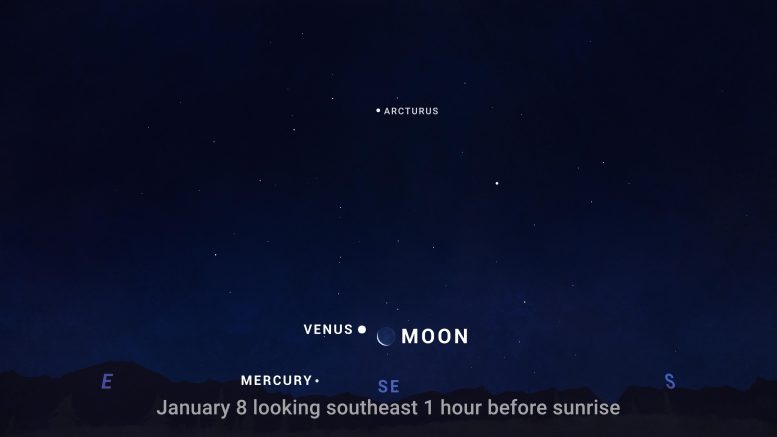
Skywatching in January 2024 features the Quadrantid meteor shower, planetary conjunctions with the Moon, and the ever-changing star positions due to Earth’s orbit, with stars rising four minutes earlier each day. Credit: SciTechDaily.com
What are some skywatching highlights in January 2024?
The year kicks off with the Quadrantid meteors, and some great Moon-planet pairings. Plus, did you know the stars shift in the sky by four minutes each day?
WHAT TO LOOK FOR:
Meteors and shifting stars!
The moderate Quadrantid meteor shower is active from December 28 to January 12, and peaks overnight on January 3. The Moon will wash out faint meteors, but the shower often produces bright fireball meteors. And while you have likely noticed how the constellations shift over the seasons, did you know that change happens at a pace of four minutes per day?
January skywatching highlights:
- January 3 – The Quadrantid meteor shower peaks overnight and into the morning of the 4th. The third quarter moon will brighten the eastern sky after midnight, but patient skywatchers may observe a few bright “fireball” meteors.
- January 8 –Look for brilliant Venus rising with a slim crescent Moon in the southeast, in the hour before sunrise. The Moon will appear very close to bright red star Antares, appearing to pass in front of the star for observers in parts of the Western U.S. Planet Mercury is also visible, low in the southeast, this morning.
- January 11 – New moon
- January 13 & 14 – See the crescent Moon together with Saturn. Find the pair in the southwest for a couple of hours following sunset on both nights.
- January 17 & 18 – The Moon pairs up with Jupiter, appearing high in the southwest, for two evenings.
- January 14-20 – If you have access to a telescope or binoculars, this is a great week to pull them out. The presence of the first quarter moon makes for great viewing opportunities as you sweep across the sky: exploring the Moon, then Jupiter and its moons, the Pleiades, the Hyades, and the Orion Nebula.
- January 25 – Full moon

Sky chart showing Venus with the Moon, as well as Mercury, in the January 8 morning sky. Credit: NASA/JPL-Caltech
Video Transcript
What’s Up for January? Some moderate meteor activity, several great pair-ups of the Moon and planets, and how just four minutes a day can make a big difference in your view of the universe…
The year kicks off with the Quadrantid meteor shower, which peaks after midnight on January 4th. Light from the third-quarter moon will brighten the sky on the peak night, causing fainter meteors to be lost from view. But the shower does produce a decent number of bright meteors called fireballs, so it can still be worth your time. If viewing from a dark sky location, you may see 20-25 meteors per hour at the peak. You can catch a few meteors in the few days before or after, as well. In fact, the shower is active through around January 12th, so you might catch a fireball in the week after the peak when the Moon has moved out of the predawn sky.
On January 8th, in the hour before sunrise, look for brilliant Venus rising with a slim crescent Moon in the southeast. Bright star Arcturus hangs high above them. The Moon will appear quite close to the red giant star Antares, the fiery red heart of Scorpius, that morning. And for observers in parts of the Western U.S., the Moon will actually occult, or pass in front of, Antares as the pair are rising that morning. And if you have a view of the horizon, this is also good morning to spot Mercury before the sky brightens. It’s quite low, but rises above 10 degrees off the horizon as dawn warms the sky, and it will be shining even brighter than Arcturus.
Next up, the crescent moon visits Saturn on the 13th and 14th. You’ll find the pair in the southwest for a couple of hours following sunset both nights. Then the Moon pairs up with Jupiter in the evening on the 17th and 18th. This is actually a great week to pull out the telescope or binoculars, because as soon as it’s fully dark, you can work your way across the sky, starting with Jupiter and its moons, our own Moon, the Pleiades, Aldebaran and the Hyades star cluster, and the Orion Nebula.
One of the things that makes skywatching so interesting is that the sky is always changing. The stars rise in the east and set in the west each night. The Moon gradually waxes and wanes as it goes through its monthly cycle. And likely you’ve also noticed that which stars you can see on a given night changes slowly over the course of the year. The bright stars and constellations we see on warm summer nights are not the ones that fill the chilly sky in winter.
This is because the stars rise 4 minutes earlier each day, and it adds up over time. In just 1 week, a given star will rise 28 minutes earlier than it does tonight. And in 1 month, the same star will be rising about 2 hours earlier. So at 4 minutes per day, or 2 hours per month, after 6 months, the stars of summer are rising a full 12 hours earlier than they did back in June, placing them high in the daytime sky. But in their place, the evening sky belongs to the stars of winter.
This slow-motion cycle in the sky plays out annually as Earth moves in its orbit around the Sun. Our view outward into space during the night depends on where Earth is in its orbit. At one part of the year, our view of space from Earth’s night side looks in one direction, and six months later the view is in the opposite direction. And so our nighttime view of the cosmos changes over the course of the year, because the stars aren’t moving, we are! And that change happens at a pace of 4 minutes per day.
Here are the phases of the Moon for January. Stay up to date on NASA’s missions exploring the solar system and beyond at science.nasa.gov. I’m Preston Dyches from NASA’s Jet Propulsion Laboratory, and that’s What’s Up for this month.









I have been off of morphine sulfate 15mg ir ×2 ea 3times a day for 7 years.Now I am at the point of surgery on my feet . I will be needing opioid for the recovery which is my best one to take?
Try to avoid them if possible. What seems like the quickest best most convenient option usually leads to the worst long-term results. Quintessential example here.
I used cannabis, it worked for me. I chose not to use opioids due to the addiction factor. I have 3 chronic illnesses that caused pain and I am able to function normally on most days. Good luck.